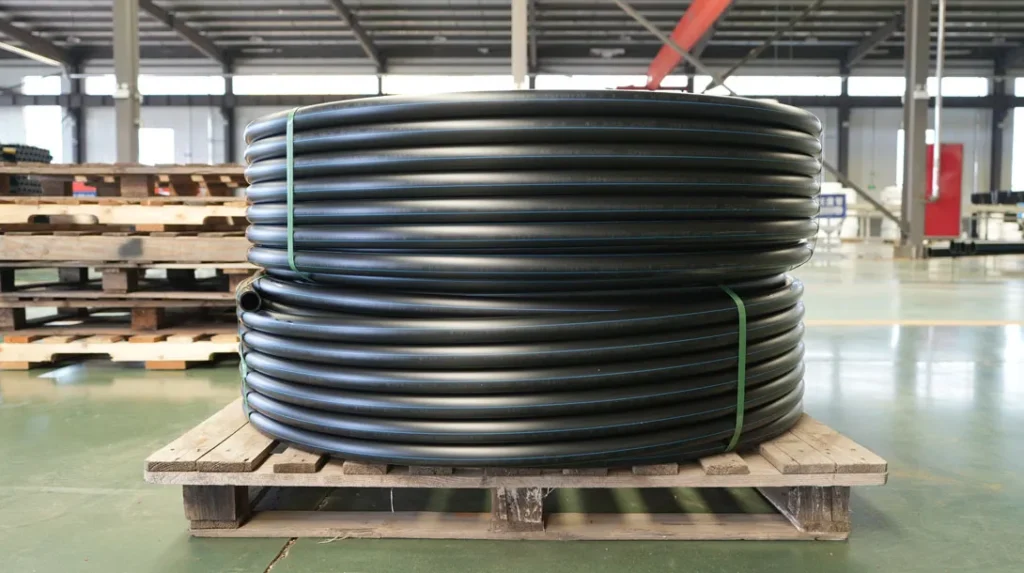In the current era of vigorous infrastructure development, the upgrading of water supply and gas supply systems, as well as the expansion of special fields such as underwater vessels, have put forward higher requirements for pipeline performance. PE pipes stand out in the market with their excellent performance and advantages, and their future application prospects are extremely promising.

PE pipes, namely polyethylene pipes synthesized from ethylene, are thermoplastic materials that can be manufactured into coils or straight pipes up to 40 feet in length. These different forms are suitable for various engineering requirements. The diverse wall thickness measurement systems, including iron pipe size inner diameter, pipe size determined by constant outer diameter (DR), and copper pipe size outer diameter, provide possibilities for precise selection under different working conditions.
PE pipe fittings, which complement PE pipes, play a crucial role in pipeline systems. Whether it is connecting straight pipes, changing the shape of pipelines, or regulating fluid flow, PE pipe fittings are indispensable. Most manufacturers offer mechanical connectors that enable the connection of PE pipes to pipes made of other materials. Flange connectors and transition joints provide convenience for the construction of complex pipeline systems.
The characteristics of PE pipes are truly remarkable. Their light weight greatly reduces transportation and installation difficulties, enabling them to quickly surpass traditional pipes such as clay pipes and cement pipes in market share. In terms of flexibility, PE pipes can be bent to a radius of approximately 30 times the nominal diameter or less. In practical projects, a 12-inch PE pipe can be bent to a radius of 32 feet on-site. This feature reduces the number of fittings required for pipeline redirection, simplifies the installation process, and improves construction efficiency.
Chemical resistance is another highlight of PE pipes. They have properties such as rust resistance, decay resistance, pitting resistance, and can withstand the erosion of various chemicals. In industries with extremely high requirements for corrosion resistance, such as chemical engineering and pharmaceuticals, PE pipes have become the preferred choice for pipeline materials. In addition, the leak-proof joints formed by hot melt connection of PE pipes have a strength comparable to that of the pipes themselves, effectively reducing leakage points in municipal projects and lowering maintenance costs. Their extremely long service life is also remarkable. If designed, constructed, and operated in accordance with industry standards and manufacturer recommendations, the service life of PE pipes can reach 50 to 100 years, achieving a perfect combination of economy and practicality.
In the field of applications, PE pipes demonstrate strong adaptability, and numerous practical cases confirm their outstanding performance. In municipal buried water supply, a southern city used PE 100 water supply pipes in an old pipeline renovation project, with a total laying length of 50 kilometers. Compared with the original cast iron pipes, the smooth inner wall of PE pipes significantly reduced frictional resistance during water transportation, increasing water supply efficiency by approximately 20%. Meanwhile, their corrosion resistance effectively prevented water pollution caused by pipeline rust, ensuring the safety of residents’ water use. In the field of building water supply, a 30-story commercial office building selected PE pipes during construction. Due to their light weight, the load-bearing pressure on the building structure was significantly reduced. Moreover, large-scale hoisting equipment was not required during installation, shortening the construction period by 15 days and reducing construction costs.
In agricultural irrigation, a 10,000-mu vineyard in Xinjiang adopted a PE drip irrigation pipeline system. This system precisely delivered water to the root of each grapevine through PE pipes. The flexibility of PE pipes allowed them to easily adapt to the complex terrain of the vineyard, reducing the use of elbows and lowering pipeline laying costs. Compared with traditional irrigation methods, the use of PE drip irrigation pipes increased water resource utilization by 40% and grape production by 15%, resulting in significant economic benefits.
PE gas pipes also perform excellently. In a natural gas household connection renovation project in northern China, PE 80 gas pipes were used for gas transportation within the community. The good impact resistance of these pipes prevented them from cracking during construction in cold winter, and the reliable and stable hot melt connection method ensured the safety of gas transportation. Since the completion of the project, not a single gas leakage accident has occurred, safeguarding the lives and property of residents.
With the continuous growth of the market demand for pipeline products, simple and efficient PE pipe connection methods are becoming increasingly important. PE pipe manufacturers have also actively responded by designing perfect systems to ensure the compatibility of products with various fittings and components. For engineers and purchasers, familiarity with PE pipes and fittings is the key to the smooth progress of projects.
Looking to the future, against the backdrop of continuous infrastructure construction and increasingly stringent environmental requirements, PE pipes, with their excellent performance and cost advantages, will surely be applied in more fields, injecting continuous impetus into the development of the modern fluid conveyance field.


